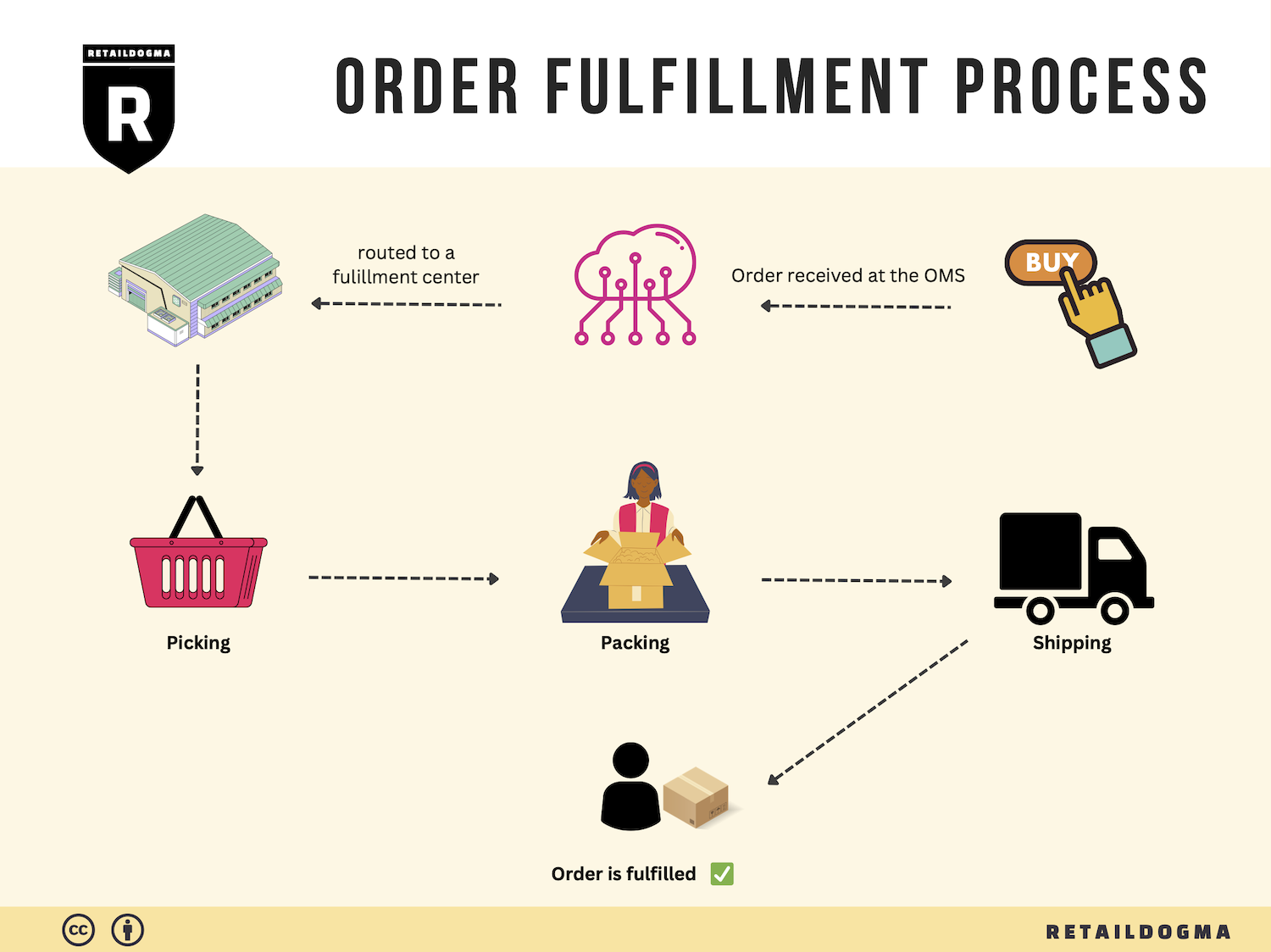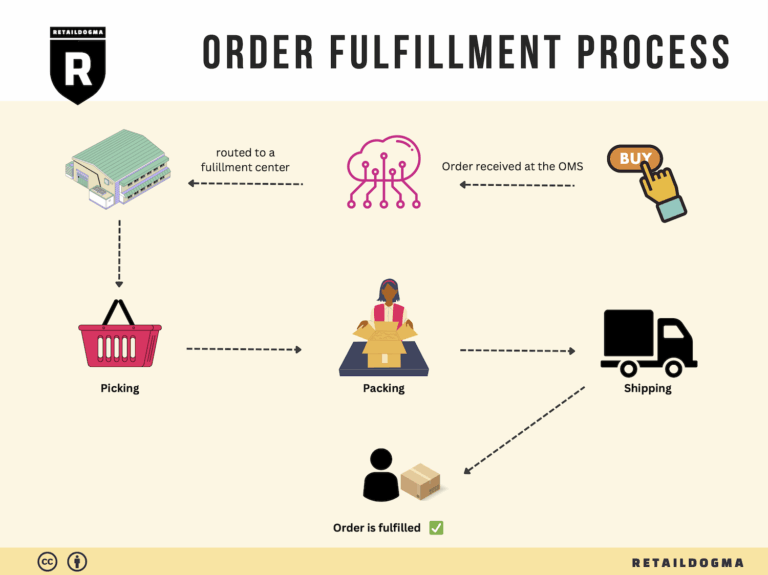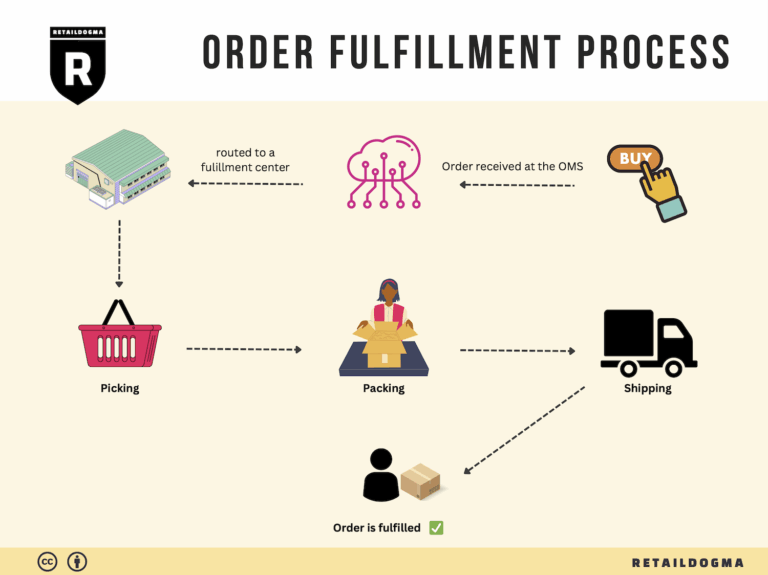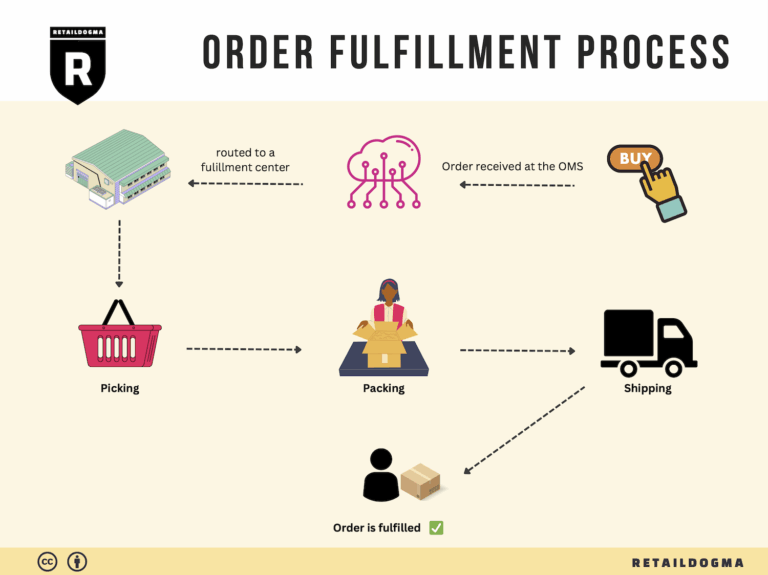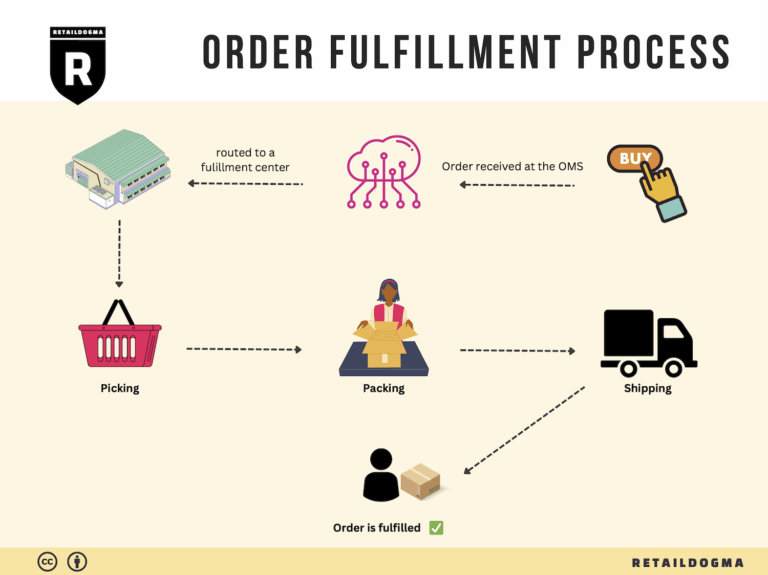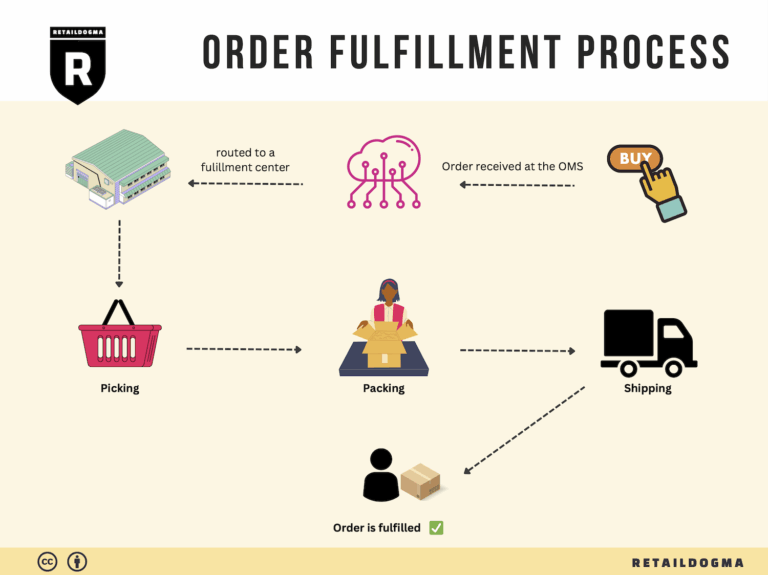How Order Fulfillment Works: A Step-by-Step Guide for Businesses
What is E-commerce Fulfillment? An Introduction for Growing Businesses
Understanding E-commerce Fulfillment: A Guide for Growing Businesses
As an e-commerce business owner, you may find yourself grappling with the overwhelming task of packing and shipping orders. The excitement of growing sales can quickly turn into a logistical nightmare if you are not equipped to handle fulfillment efficiently. At its core, e-commerce fulfillment is the entire process of getting a product from your inventory to your customer’s doorstep. This crucial component can make or break your customer experience and, ultimately, your business’s success.
In this guide, we will delve into the various fulfillment models available to growing businesses, including Third-Party Logistics (3PL) and Fulfillment by Amazon (FBA). Understanding these models is essential for selecting the right approach that aligns with your operational needs and customer expectations.
We will also explore the core services offered by fulfillment providers, which often include inventory storage, order processing, packing, shipping, and returns management. Each service plays a pivotal role in ensuring that your orders are handled smoothly and efficiently.
Choosing the right fulfillment partner can be a daunting task, especially with the multitude of options available. This guide will provide you with practical insights on how to evaluate potential partners, considering factors such as their technology capabilities, location, scalability, and customer service. A well-chosen partner can enhance your operational efficiency and significantly improve your customer satisfaction rates.
Pricing is another critical area we will cover. Understanding the cost structures associated with different fulfillment models will help you budget effectively and make informed financial decisions. We will break down common pricing strategies, including per-order fees, storage fees, and shipping costs, so you can anticipate your expenses and maximize your profit margins.
The goal of this guide is to empower your business to make smart decisions about your logistics and fulfillment strategies. By equipping you with the knowledge to navigate the complexities of e-commerce fulfillment, we aim to help you scale your operations smoothly and sustainably. Whether you are just starting or looking to optimize your existing processes, this guide will serve as a valuable resource on your journey to fulfilling customer expectations and driving growth.
What You’ll Learn In This Guide
- What is E-commerce Fulfillment? An Introduction for Growing Businesses
- The Order Fulfillment Process: From ‘Buy’ Button to Customer’s Door
- Comparing Fulfillment Models: In-House vs. 3PL vs. Dropshipping
- A Deep Dive into Amazon FBA: Pros, Cons, and Who It’s For
- Core Services Offered by Fulfillment Centers
- How to Choose a Fulfillment Partner: A 6-Point Checklist
- Understanding Fulfillment Pricing: A Breakdown of Common Fees
- Frequently Asked Questions (FAQs) about Fulfillment
- Conclusion: Is Outsourcing Fulfillment the Right Move for Your Business?
- Important Disclaimer
The Order Fulfillment Process: From ‘Buy’ Button to Customer’s Door
1. Receiving Inventory
The first step in the order fulfillment process is the receiving of inventory. This involves the systematic acceptance of goods into the warehouse from suppliers or manufacturers. Upon arrival, each item is inspected for quality and quantity, ensuring that what was ordered matches what is delivered. This is typically tracked using Stock Keeping Units (SKUs), which are unique identifiers for each product, allowing for precise inventory management.
Importance: Properly receiving inventory is crucial as it sets the foundation for all subsequent steps in the fulfillment process. If items are not accurately recorded, it can lead to stock discrepancies, which may result in stockouts or overstock situations. Both scenarios can negatively impact customer satisfaction and operational efficiency.
Key Term: SKU (Stock Keeping Unit) – a unique identifier for each product that aids in inventory tracking.
2. Warehouse Storage
Once inventory has been received and verified, it is stored in designated locations within the warehouse. This step involves organizing items in a manner that maximizes efficiency and accessibility. Depending on the size and nature of the products, storage methods may include shelving, bins, or pallet racking systems.
Importance: Effective warehouse storage is vital for optimizing space and facilitating quick access to products. A well-organized warehouse minimizes the time employees spend searching for items and reduces the risk of errors when picking orders. Moreover, it enhances inventory turnover rates, which is essential for maintaining a healthy cash flow.
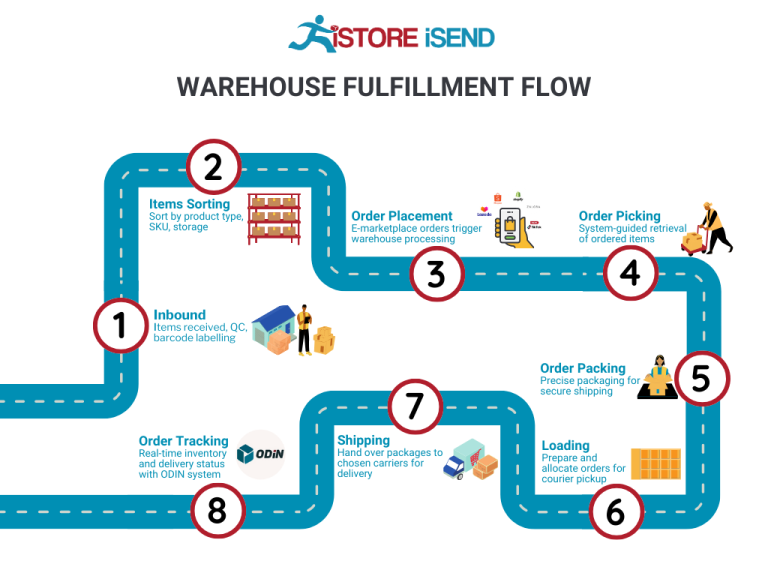
Key Term: Bin Location – a specific area in the warehouse where a product is stored, often indicated in the warehouse management system (WMS).
3. Order Picking
When a customer places an order, the next step is order picking. This involves selecting the correct items from their storage locations to fulfill the order. Warehouse associates often utilize pick lists, which detail the items and quantities needed for each order. Depending on the fulfillment strategy, picking methods can vary, including single order picking or batch picking, where multiple orders are picked simultaneously.
Importance: Order picking is one of the most labor-intensive and error-prone steps in the fulfillment process. Efficient picking is essential for ensuring that customers receive the correct products in a timely manner. Reducing picking errors not only enhances customer satisfaction but also minimizes returns and additional shipping costs.
Key Term: Pick List – a document or digital tool that outlines the items to be collected for fulfilling an order, guiding warehouse staff during the picking process.
4. Order Packing
After items have been picked, they move to the packing stage. In this step, products are carefully packaged to ensure they arrive safely at the customer’s door. This includes selecting appropriate packaging materials, labeling, and sometimes including additional items like invoices or promotional materials.
Importance: Packing is critical for protecting products during transit and ensuring compliance with shipping regulations. A well-packed order reduces the likelihood of damage, which can lead to customer dissatisfaction and increased costs due to returns or replacements. Additionally, effective packing can optimize shipping costs by minimizing the size and weight of packages.
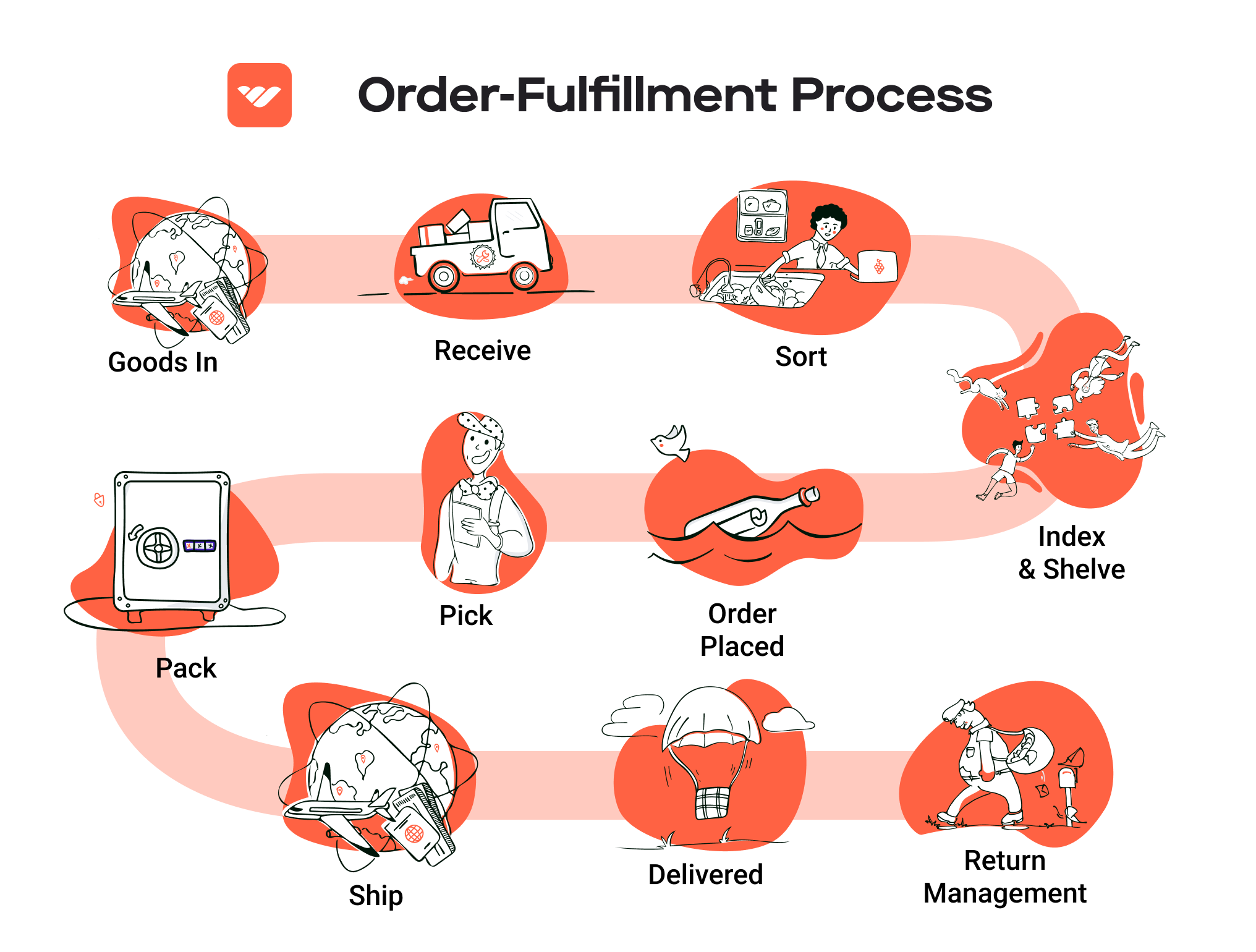
Key Term: Packaging Material – materials used to protect and contain products during shipping, including boxes, bubble wrap, and packing peanuts.
5. Shipping & Delivery
The final step in the order fulfillment process is shipping and delivery. Once orders are packed, they are labeled with shipping information and handed over to carriers for transportation. This process often involves choosing the most cost-effective and timely shipping methods, which may include standard, expedited, or same-day delivery options.
Importance: The shipping and delivery phase is the culmination of the entire fulfillment process and significantly influences customer satisfaction. Timely and accurate delivery can enhance the customer experience and encourage repeat business. Moreover, effective shipping strategies can also reduce costs and improve profitability.
Key Term: Last-Mile Delivery – the final step of the shipping process where the package is delivered from a transportation hub to the final destination, often considered the most critical part of the delivery process due to its impact on customer satisfaction.
By understanding and optimizing each of these steps, e-commerce businesses can enhance their order fulfillment processes, ultimately leading to improved customer experiences and increased operational efficiency.
Comparing Fulfillment Models: In-House vs. 3PL vs. Dropshipping
Fulfillment Model Comparison Table
| Model | Who Handles Inventory | Best For (Business Stage) | Key Advantage | Key Disadvantage |
|---|---|---|---|---|
| In-House Fulfillment | The business itself | Established businesses | Greater control over inventory and processes | High upfront costs and operational complexity |
| Third-Party Logistics (3PL) | A third-party logistics provider | Growing businesses | Scalability and reduced operational burden | Less control over the fulfillment process |
| Dropshipping | Suppliers or manufacturers | Startups and small businesses | Low startup costs and no inventory management | Lower profit margins and potential supplier issues |
In-House Fulfillment
In-house fulfillment involves managing all aspects of the order fulfillment process internally. This model is typically adopted by established businesses that have the resources and infrastructure to handle inventory storage, packing, and shipping. Companies that choose this route can maintain greater control over their inventory, processes, and customer service. This control allows for tailored branding and a consistent customer experience, which can be critical in building customer loyalty. However, the disadvantages include significant upfront investment in warehousing, staffing, and technology. Additionally, managing fulfillment operations can divert attention from core business activities, leading to operational complexity. Businesses also need to consider fluctuations in demand, as excess inventory can lead to increased holding costs, while insufficient stock can result in lost sales.
Third-Party Logistics (3PL)
Third-party logistics (3PL) providers manage the logistics and fulfillment functions on behalf of a business. This model is particularly advantageous for growing companies that need to scale operations without the burden of managing logistics themselves. 3PLs offer a range of services, including warehousing, inventory management, order fulfillment, and shipping. By outsourcing these functions, businesses can focus on their core competencies such as marketing and product development. The scalability of 3PL services allows businesses to adapt quickly to changes in demand without the need for significant capital investment in facilities or technology. However, a key disadvantage is the reduced control over the fulfillment process, which can impact customer satisfaction if the 3PL provider does not meet performance expectations. Additionally, businesses may face challenges in integrating their systems with those of the 3PL, leading to potential inefficiencies.
Dropshipping
Dropshipping is a fulfillment model where the retailer does not keep products in stock. Instead, when a retailer sells a product, it purchases the item from a third party (usually a wholesaler or manufacturer) who then ships it directly to the customer. This model is ideal for startups and small businesses that want to minimize upfront investment and operational complexity. Since there is no need to maintain inventory, businesses can offer a wider range of products without the risk of unsold stock. However, dropshipping comes with its own set of challenges. The profit margins are often lower compared to other models, as suppliers take a cut of the sales. Additionally, retailers rely heavily on their suppliers for inventory and shipping, which can lead to issues such as stockouts, shipping delays, and quality control problems. This reliance can hinder the ability to provide a consistent customer experience, which is vital for building brand reputation and customer loyalty.
Conclusion
Choosing the right fulfillment model is crucial for e-commerce businesses looking to scale effectively. Each model—In-House Fulfillment, 3PL, and Dropshipping—offers unique advantages and challenges that must be weighed carefully against the business’s specific needs, resources, and growth stage. By understanding these models and aligning them with business goals, entrepreneurs can enhance operational efficiency and improve customer satisfaction, ultimately driving growth in a competitive marketplace.
A Deep Dive into Amazon FBA: Pros, Cons, and Who It’s For
Understanding Fulfillment by Amazon (FBA)
Fulfillment by Amazon (FBA) is a service offered by Amazon that allows e-commerce sellers to store their products in Amazon’s fulfillment centers. This means that Amazon takes care of storage, packaging, shipping, and customer service for these products. Sellers simply need to send their inventory to Amazon, and once their products are listed, Amazon handles the rest. This service can significantly streamline logistics for businesses, enabling them to scale operations without the overhead of managing fulfillment in-house.
How FBA Works
-
Setup: Sellers create an Amazon seller account and choose to enroll in FBA. They list their products on Amazon and indicate that they want to use FBA for those items.
-
Inventory Shipping: Sellers prepare their products according to Amazon’s guidelines and ship them to designated Amazon fulfillment centers.
-
Storage: Once received, Amazon stores the products in its warehouses. The seller’s inventory is managed within the Amazon ecosystem.
-
Order Processing: When a customer places an order for a product, Amazon picks, packs, and ships the item on behalf of the seller.
-
Customer Service: Amazon also handles customer inquiries, returns, and refunds related to FBA products, providing a seamless experience for buyers.
-
Reporting: Sellers have access to reports that detail sales performance, inventory status, and customer feedback, allowing them to make informed business decisions.
Pros of Using FBA
Prime Eligibility
One of the most significant advantages of using FBA is the ability to offer products with Amazon Prime eligibility. Prime members enjoy free two-day shipping on eligible items, which can dramatically increase sales potential, as many consumers prefer to buy from Prime-eligible sellers.
Increased Customer Trust
Products fulfilled by Amazon benefit from the trust associated with the Amazon brand. Customers are more likely to purchase from sellers that utilize FBA due to the perception of reliability, fast shipping, and excellent customer service.
Multi-Channel Fulfillment
FBA isn’t limited to Amazon’s marketplace. Sellers can also use FBA to fulfill orders from their own websites or other marketplaces. This flexibility allows businesses to streamline their logistics across multiple sales channels, further enhancing operational efficiency.
Scalability
With Amazon handling storage and fulfillment, businesses can scale their operations rapidly without the need to invest in their own warehousing and logistics infrastructure. This allows sellers to focus on growth strategies rather than day-to-day fulfillment challenges.
Advanced Technology and Infrastructure
Sellers benefit from Amazon’s sophisticated logistics network and technology, which ensures efficient inventory management and order processing. This infrastructure can be challenging and costly to replicate independently.
Cons of Using FBA
High Fees
While FBA provides many advantages, it comes at a cost. Amazon charges various fees, including storage fees for the inventory stored in its warehouses and fulfillment fees for each order processed. These costs can add up quickly, eating into profit margins, especially for lower-priced items.
Strict Inventory Rules
Sellers must adhere to Amazon’s strict inventory management policies, including requirements for labeling, packaging, and storage limits. Failure to comply can result in additional fees or penalties, making it crucial for sellers to stay informed and organized.
Commingling Risks
FBA operates on a commingling model, where inventory from different sellers may be stored together. This can lead to issues if a customer receives a product that has been damaged or misrepresented. Sellers may also face challenges if they need to track down their own inventory amidst mixed stock.
Limited Control Over Fulfillment
When using FBA, sellers relinquish control over the fulfillment process. This means they cannot customize packaging or branding as they might if they were fulfilling orders themselves. For brands that prioritize customer experience, this can be a significant drawback.
Dependency on Amazon
Relying on FBA can create a dependency on Amazon’s platform. Changes in Amazon’s policies, fees, or algorithms can significantly impact a seller’s business. This risk necessitates careful consideration and strategic planning for long-term sustainability.
Who is FBA Best For?
Fulfillment by Amazon is best suited for:
-
Small to Medium-Sized Businesses: Companies looking to scale quickly without investing heavily in logistics can benefit from FBA’s infrastructure and services.
-
E-commerce Entrepreneurs: New sellers entering the market can leverage FBA to gain access to Amazon’s vast customer base while minimizing initial operational burdens.
-
Brands Seeking Increased Visibility: Businesses aiming to enhance their brand’s visibility and credibility can utilize FBA to capitalize on Amazon’s trusted platform.
-
Sellers with High Sales Volume: Those with a large volume of sales can offset FBA’s fees with increased sales, making it a viable option for larger businesses.
-
Multi-Channel Sellers: Brands selling on multiple platforms can benefit from FBA’s multi-channel fulfillment capabilities, streamlining operations across various sales channels.
In conclusion, while FBA offers numerous advantages that can enhance an e-commerce business’s efficiency and reach, it is essential to weigh these benefits against the associated costs and risks. By carefully evaluating their specific needs and capabilities, sellers can determine whether FBA is the right fit for their growth strategy.
Core Services Offered by Fulfillment Centers
Inventory Management & Warehousing
Inventory management and warehousing are foundational services provided by fulfillment centers. This process involves the systematic tracking and control of inventory levels, orders, sales, and deliveries. Fulfillment centers utilize advanced technology, including inventory management systems, to maintain optimal stock levels, preventing both overstocking and stockouts.
The benefits of effective inventory management are manifold for e-commerce businesses. Firstly, it enhances operational efficiency by ensuring that products are readily available when needed, which in turn boosts customer satisfaction. Quick and accurate inventory tracking allows businesses to respond swiftly to demand fluctuations, aiding in maintaining a competitive edge. Moreover, improved inventory management helps reduce costs associated with excess inventory, such as storage fees and waste, ultimately leading to better cash flow and profitability.
Pick and Pack Services
Pick and pack services are critical to the fulfillment process, where products are selected (picked) from inventory and then packaged (packed) for shipment to customers. Fulfillment centers employ skilled personnel and efficient systems to ensure that orders are accurately fulfilled and shipped promptly.
The advantages of pick and pack services for e-commerce businesses include increased order accuracy and speed. By utilizing automated systems and optimized workflows, fulfillment centers can minimize errors in order fulfillment, leading to higher customer satisfaction. Additionally, the ability to scale these services allows businesses to manage seasonal spikes in order volume without compromising service quality. This flexibility is essential for maintaining a positive brand reputation and fostering customer loyalty.
Kitting and Assembly
Kitting and assembly services involve grouping individual items into ready-to-sell packages or assembling components into final products before shipping. This service is particularly beneficial for businesses that sell complex products or bundles, such as subscription boxes or promotional kits.
For e-commerce businesses, kitting and assembly streamline the production process, reducing the time it takes to prepare products for sale. By outsourcing these tasks to fulfillment centers, businesses can focus on core competencies such as marketing and customer service. Additionally, kitting can lead to increased sales opportunities by encouraging customers to purchase bundled products at a discounted rate, enhancing average order value and improving inventory turnover.
Returns Management (Reverse Logistics)
Returns management, or reverse logistics, is the process of handling product returns from customers. This service includes everything from processing returns and inspecting items to restocking products or managing exchanges. Efficient returns management is vital for e-commerce businesses, as it directly impacts customer satisfaction and retention.
An effective returns management system provides several benefits. Firstly, it simplifies the return process for customers, making them more likely to shop again if they know returns are easy and hassle-free. Furthermore, robust reverse logistics can help businesses recover value from returned items through refurbishment or resale, minimizing losses. By analyzing return data, businesses can also identify trends or issues with specific products, enabling them to make informed decisions about inventory, product quality, and supplier performance.
Conclusion
The core services offered by fulfillment centers, including inventory management, pick and pack services, kitting and assembly, and returns management, are essential for e-commerce businesses looking to scale effectively. By leveraging these services, businesses can enhance operational efficiency, improve customer satisfaction, and ultimately drive growth. As the e-commerce landscape continues to evolve, partnering with a capable fulfillment center can provide the competitive advantage needed to thrive in a dynamic market.
How to Choose a Fulfillment Partner: A 6-Point Checklist
Location & Warehouse Network
Importance: The geographic location of your fulfillment partner’s warehouses can significantly impact shipping times and costs. A strategically placed network of warehouses allows for quicker deliveries to your customers, which enhances the overall customer experience and can reduce shipping expenses.
Questions to Ask:
– Where are your warehouses located, and how many do you operate?
– How does your warehouse network align with my target customer demographics?
– Can you provide regional shipping rates and delivery times for these locations?
Technology & Integrations
Importance: In today’s fast-paced e-commerce environment, robust technology and seamless integrations with your existing systems (like your e-commerce platform, inventory management, and customer service software) are crucial. Efficient technology helps streamline operations, manage inventory in real-time, and provide valuable insights into your supply chain.
Questions to Ask:
– What technology solutions do you offer for order tracking and inventory management?
– How do you integrate with popular e-commerce platforms (e.g., Shopify, WooCommerce, Amazon)?
– Can you provide API access for custom integrations?
Specializations (e.g., Cold Storage, Oversized Items)
Importance: Depending on the nature of your products, you may need a fulfillment partner that specializes in handling specific types of inventory, such as perishables requiring cold storage, or oversized items that need specialized handling. Choosing a partner with the right expertise can prevent damage and ensure compliance with regulations.
Questions to Ask:
– Do you have specialized facilities for handling specific types of products (e.g., temperature-sensitive items, hazardous materials)?
– What experience do you have in managing oversized or bulky items?
– Can you provide examples of how you’ve successfully managed similar products for other clients?
Scalability & Capacity
Importance: As your business grows, your fulfillment needs will evolve. A good fulfillment partner should be able to scale operations to match your growth trajectory, whether that means handling increased order volumes, expanding into new markets, or accommodating seasonal spikes in demand.
Questions to Ask:
– How do you handle seasonal fluctuations in order volume?
– What is your capacity for scaling operations, and how quickly can you adapt to increased demand?
– Can you provide case studies or references from clients who have scaled with you?
Pricing and Contracts
Importance: Understanding pricing structures and contract terms is essential to avoid unexpected costs that can eat into your margins. Clarity on pricing can help you budget effectively and ensure that you’re getting value for your money.
Questions to Ask:
– What is your pricing structure (e.g., per order, per item, monthly fees)?
– Are there any additional fees I should be aware of (e.g., storage fees, handling fees)?
– What are the terms of your contract, and is there flexibility for renegotiation as my business grows?
Customer Support & Reviews
Importance: A responsive and knowledgeable customer support team can make a significant difference in your day-to-day operations. Additionally, reviewing customer feedback and testimonials can provide insights into the reliability and quality of service offered by a potential partner.
Questions to Ask:
– What customer support options do you provide (e.g., dedicated account manager, 24/7 support)?
– Can you share customer references or case studies that demonstrate your service quality?
– How do you handle issues or discrepancies in order fulfillment?
Final Thoughts
Selecting the right fulfillment partner is a critical decision that can greatly impact your e-commerce business’s efficiency and customer satisfaction. By using this checklist, you can ensure that you consider all key factors and ask the right questions to find a partner that aligns with your business goals and operational needs. Make sure to assess potential partners thoroughly and choose one that not only meets your current requirements but can also grow alongside your business.
Understanding Fulfillment Pricing: A Breakdown of Common Fees
Initial Setup Fees
When partnering with a fulfillment center, many e-commerce businesses encounter initial setup fees. These fees typically cover the costs associated with onboarding your account, including system integration, inventory setup, and the establishment of operational protocols. The fees can vary significantly based on the complexity of your needs. For instance, businesses requiring custom software solutions or unique inventory management systems may face higher setup costs than those with straightforward requirements.
To calculate initial setup fees, fulfillment centers generally consider the following factors:
- Complexity of Integration: More complex systems require more time and resources to implement.
- Inventory Size and Type: Larger inventories or those needing special handling may incur additional costs.
- Customization Needs: Tailored solutions to meet specific business needs will typically increase setup fees.
Receiving Fees
Receiving fees are charged when your inventory arrives at the fulfillment center. These fees compensate the center for the labor and resources involved in unloading, inspecting, and storing your goods. The calculation of receiving fees can depend on several factors:
- Volume of Inventory: Fees are often calculated on a per-unit basis, with larger shipments attracting lower per-item costs due to economies of scale.
- Handling Complexity: If your products require special handling or inspection, additional fees may apply.
- Time of Delivery: Some fulfillment centers charge extra for receiving shipments during peak hours or weekends.
Understanding the breakdown of receiving fees can help you plan your inventory shipments more effectively.
Storage Fees (per pallet/bin)
Storage fees are recurring costs associated with holding your inventory within the fulfillment center. These fees are typically calculated based on the volume of space your products occupy, measured in pallets or bins. There are a few key considerations:
- Duration of Storage: Most centers charge monthly fees, and the longer your products remain in storage, the more you pay.
- Type of Storage: Temperature-controlled or special handling storage may incur higher fees than standard storage.
- Inventory Turnover Rate: Slow-moving items may attract additional long-term storage fees, encouraging businesses to manage their inventory more efficiently.
To mitigate storage costs, consider optimizing your inventory turnover and aligning shipments with demand forecasts.
Pick & Pack Fees (per item/order)
Pick and pack fees are charged for the labor involved in retrieving items from storage and preparing them for shipment. These fees can vary based on:
- Number of Items: Many fulfillment centers charge a flat fee per order, plus an additional fee for each item picked.
- Complexity of Packing: Orders requiring special packaging, inserts, or custom labeling may incur higher fees.
- Volume of Orders: Businesses with high order volumes may negotiate lower per-order fees due to economies of scale.
Understanding how pick and pack fees are structured can help you design your product offerings and packaging to minimize costs.
Shipping Fees
Shipping fees cover the costs of transporting your orders to customers. These fees can fluctuate based on several factors:
- Shipping Method: Different carriers and service levels (e.g., standard vs. expedited) will have varying costs.
- Destination: Shipping fees are typically higher for distant or international locations.
- Weight and Dimensions: Carriers often charge based on the dimensional weight of the package, so optimizing packaging can reduce costs.
Many fulfillment centers offer discounted shipping rates through partnerships with carriers, which can benefit businesses looking to manage shipping expenses effectively.
Tips for Getting an Accurate Quote
-
Provide Detailed Information: When requesting a quote, give the fulfillment center comprehensive details about your business model, inventory types, and shipping volumes. This helps them tailor their pricing to your needs.
-
Ask for a Breakdown of Fees: Request a detailed quote that outlines all potential fees, including any variable costs, so you can understand the full financial commitment.
-
Consider Seasonal Fluctuations: If your business experiences seasonal spikes in sales, discuss how this affects pricing, especially for storage and shipping fees.
-
Negotiate Based on Volume: If you anticipate significant order volumes, leverage this in negotiations to secure better rates on storage, pick and pack, and shipping fees.
-
Review Contracts Carefully: Always read the fine print in contracts to identify any hidden fees or terms that could affect your costs.
By understanding these common fulfillment pricing models and following these tips, you can make informed decisions that enhance your e-commerce operations and support scalable growth.
Frequently Asked Questions (FAQs) about Fulfillment
1. What is a fulfillment center, and how does it differ from a warehouse?
A fulfillment center is a specialized type of warehouse designed to handle the storage, packing, and shipping of products directly to customers. Unlike traditional warehouses that primarily focus on storage, fulfillment centers are optimized for fast processing of orders, often incorporating advanced technology and automation to streamline operations. This allows businesses to fulfill customer orders quickly and efficiently, enhancing the overall customer experience.
2. What services does Amazon Fulfillment Center – ORD4 offer?
Amazon Fulfillment Center – ORD4 provides a range of services including inventory storage, order processing, packing, and shipping. They also offer returns management, customer support for order inquiries, and integration with various e-commerce platforms. This comprehensive service suite allows businesses to outsource their logistics and focus on growth.
3. How much do fulfillment services cost?
The cost of fulfillment services can vary widely based on factors such as order volume, storage space required, and specific service offerings. Generally, costs include storage fees (per cubic foot), pick and pack fees (per item), and shipping fees. It’s advisable to obtain quotes from fulfillment centers like Amazon ORD4 to understand the pricing structure that fits your business needs.
4. What is a third-party logistics provider (3PL)?
A third-party logistics provider (3PL) is a company that offers logistics services to other businesses, which can include warehousing, fulfillment, transportation, and distribution. Utilizing a 3PL allows businesses to outsource their supply chain management, enabling them to focus on their core competencies while leveraging the expertise and resources of the 3PL.
5. How can I ensure my products are stored safely in a fulfillment center?
To ensure the safety of your products in a fulfillment center like Amazon ORD4, it’s important to partner with a facility that prioritizes security and inventory management. Look for features such as climate control, fire suppression systems, surveillance cameras, and robust inventory tracking systems. Additionally, regularly communicating with the fulfillment center about your specific storage needs can help maintain product integrity.
6. What technologies are used in Amazon Fulfillment Centers?
Amazon Fulfillment Centers utilize a variety of advanced technologies, including robotics for picking and packing, automated sorting systems, and sophisticated inventory management software. These technologies enhance operational efficiency, reduce errors, and speed up the fulfillment process, allowing for quicker delivery times.
7. How do I get started with Amazon Fulfillment Center – ORD4?
To get started with Amazon Fulfillment Center – ORD4, you need to create an Amazon seller account and set up your inventory in the Amazon Seller Central platform. After configuring your account, you can send your products to the ORD4 fulfillment center, where they will be stored and fulfilled on your behalf. Amazon provides detailed guidelines to help you through the onboarding process.
8. What are the operational hours of Amazon Fulfillment Center – ORD4?
Amazon Fulfillment Center – ORD4 operates 24 hours a day, seven days a week. This round-the-clock operation allows for continuous processing of orders, ensuring that your customers receive their products in a timely manner, regardless of when they place their orders.
9. Can I track my inventory and orders in real-time?
Yes, Amazon Fulfillment Center – ORD4 provides real-time inventory tracking and order status updates through the Amazon Seller Central platform. This feature allows you to monitor stock levels, view order fulfillment progress, and manage your inventory effectively, ensuring you have the necessary data to make informed business decisions.
10. What support is available for businesses using Amazon Fulfillment Center – ORD4?
Businesses using Amazon Fulfillment Center – ORD4 have access to a range of support services, including customer service for order inquiries, technical support for using the Amazon Seller Central platform, and resources for optimizing fulfillment processes. Additionally, Amazon offers comprehensive training and documentation to help businesses maximize their use of fulfillment services.
Conclusion: Is Outsourcing Fulfillment the Right Move for Your Business?
Evaluating the Benefits of Outsourcing Fulfillment
In today’s fast-paced e-commerce landscape, outsourcing fulfillment can be a game-changer for businesses looking to scale efficiently. One of the primary benefits is time savings. By leveraging a fulfillment service, you can redirect focus from logistics to core business activities such as marketing and product development. This shift not only enhances operational efficiency but also allows for more strategic growth initiatives.
Scalability is another crucial advantage. As your sales volume fluctuates—whether due to seasonal demand, promotions, or market expansions—an experienced fulfillment partner can seamlessly adjust to your needs. This flexibility helps maintain service quality without the burden of managing additional resources or infrastructure.
Moreover, outsourcing fulfillment provides access to specialized expertise. Fulfillment centers, like those operated by Amazon, have refined processes and cutting-edge technology that enhance order accuracy and speed. These partners often have established relationships with carriers, which can lead to better shipping rates and improved delivery times—critical factors for customer satisfaction.
However, choosing the right fulfillment partner is paramount. Not all providers offer the same level of service or technology. A thorough evaluation of potential partners should include their capabilities, reputation, and alignment with your business goals.
Take Action: Assess Your Current Shipping Process
As you contemplate whether to outsource your fulfillment, consider conducting a comprehensive audit of your current shipping process. Analyze key metrics such as delivery times, costs, and customer feedback. This evaluation will help you determine if a fulfillment partner could enhance your operations and contribute to your business growth.
In conclusion, outsourcing fulfillment can significantly benefit your e-commerce venture, but it requires careful consideration and strategic planning. Take the first step today by assessing your current logistics setup and exploring the possibilities that a dedicated fulfillment partner can offer.
Important Disclaimer
⚠️ Important Disclaimer
The information in this guide is for educational purposes. Fulfillment services, pricing, and platform features change frequently. Always conduct your own due diligence and consult with providers directly before making business decisions.
